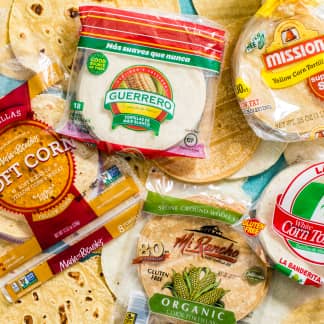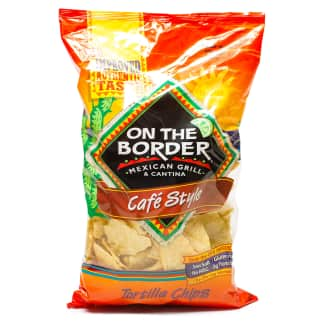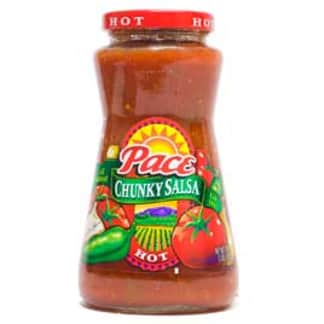Sometimes we make tortillas from scratch, but more often we reach for packaged versions. We're not alone. Americans spent more than $6 billion on tortillas in 2015, according to retail sales data gathered by the Tortilla Industry Association, with the flour variety just barely outselling corn. It has been six years since we last reviewed flour tortillas, and we wondered if our favorite from Old El Paso was still the best. We focused on 6-inch tortillas, which we use for tacos and fajitas, and found six top-selling products priced from $1.99 to $2.72 per package (packages contained eight to 20 tortillas). We sampled them in a series of blind tastings. First, we gently warmed them and tasted them plain. To see how they held up to rich and juicy fillings, we used them as taco shells with Mexican pulled pork. Then, to see how they fared when cooked, we made mini cheese quesadillas.

Tasting (and Measuring) the Tortillas
For the most part, differences in flavor were minor. Most of the tortillas tasted “neutral” and “plain.” We didn't mind; their “mild” flavor allowed the quesadilla and taco fillings to shine. Given those similarities, our tasters focused on differences in the tortillas' texture.
We wanted a wrapper sturdy enough to hold cheesy, juicy fillings without tearing or falling apart. All our tortillas achieved that basic goal, but we didn't like ones that were too stiff. Lower-ranked tortillas were oddly slick and “smooth,” which tasters likened to “compressed supermarket white bread.” Others were described as “dense,” “thick,” and “not especially tender.” When we removed them from the package, we also noticed that some tended to stick together, so we had to carefully peel individual tortillas off the stack. We preferred tortillas that were sturdy but still “very tender” and “soft” and that could be easily removed from the packaging.
To confirm what our tasters had noticed, we measured the tortillas (using samples from two bags to get an average). Sure enough, our least favorite was among the thickest—2.18 millimeters—and the heaviest—36.78 grams. Higher-ranked tortillas were consistently thinner and lighter; the best were about 1.4 millimeters thick and 23.7 grams, and tasters described them as “airy” and “light.” We also noticed that these more “delicate” tortillas had “distinct layers” and became pleasantly “crisp” when we cooked them for quesadillas.

How are Flour Tortillas Made?
It's likely that all the tortillas were made in a similar fashion. According to Tortillas: Wheat Flour and Corn Products (2015; edited by L.W. Rooney and S.O. Serna-Saldívar), the four main phases of commercial production are not unlike the steps we use to make tortillas at home. The dough is mixed and then the tortillas are formed, baked, and cooled.
Although differences in texture and overall quality can be introduced at any step, dough mixing is the most fraught. Manufacturers must pay particularly close attention to water absorption, water temperature, and mixing time, all of which can affect the “stickiness,” “appearance,” and “uniformity” of the dough.
Once mixed, the dough is divided and formed into balls, which are then stretched or flattened. This can be done by hand or using die-cut machines, but, as Ralph Waniska, a contributor to Tortillas, writes, a “hot-press” method inspired by traditional tortilla hand presses accounts for 90 percent of the retail market. In this technique, the balls of dough are placed between two flat surfaces, or plattens, and squeezed to form a flat disk. The plattens are heated electrically or with hot oil. Manufacturers can adjust the pressure, timing, and temperature of the plattens. In general, more pressure, more time, and/or higher heat result in thinner tortillas. The hot-press method is preferred, according to Waniska, because it produces tortillas with “a tender bite” that also “resist moisture absorption from fillings and have longer shelf stability.”
As for that sticking issue we'd noticed, Serna-Saldívar, editor of Tortillas, told us that it's called “zippering.” One of the best ways to prevent it is to cool the tortillas before packaging them.
We Deciphered the Ingredient Lists
All the products in our lineup had lengthy ingredient lists—much more than the flour, water, fat, and salt we use to make homemade tortillas. To ensure consistency across many large batches, manufacturers use “dough conditioners,” a general industry term that refers to an assortment of additives that change the way the dough behaves. These additives perform a variety of functions. Some make the dough less stiff or decrease the amount of time it has to rest before baking. Others increase shelf stability or prevent the tortillas from sticking.
One such additive, l-cysteine monohydrochloride, is used to shorten the time required to process the dough and make mixing the ingredients easier. It can have negative consequences, though, making the dough sticky or stiff. Worse, it can cause tortillas to crack and break more quickly. It was used in only one product in our lineup, which tasters described as “not especially tender” and having a “stale” quality even though it was nowhere near its expiration date.

We also identified a more successful additive: glycerin, a common ingredient used to retain moisture in baked goods. When we spoke with Serna-Saldívar, he explained that glycerin can help ensure that tortillas reheat well, which is important since we usually warm or cook them before serving. Glycerin also protects them from damage that can occur when tortillas are frozen and thawed, which sometimes happens during shipping. Our winner was the only product with glycerin.
Fat and Sodium Add Flavor
Finally, we compared some more familiar ingredients. First, we looked at fat. The lowest-ranked product was low in fat; it contained about 1.7 grams of fat per 32-gram serving. Most of the other tortillas contained 2 to 3 grams, and our winner had 3.1 grams. That extra fat contributes richness and flavor. We also preferred products with at least 220 milligrams of sodium per 32-gram serving.

Buy the Best Flour Tortilla
At the end of testing, our old favorite came out on top again. The Old El Paso Flour Tortillas for Soft Tacos and Fajitas ($2.49 per package) were “perfect all around.” The thinnest and lightest in our lineup, they were still sturdy enough to contain hot, melty cheese and juicy pulled pork without tearing or getting soggy. They were relatively high in fat, which ensured that they were “tender and flaky” when warmed and had “great crispness” once cooked, and glycerin helped them stay moist. There's more good news, too: Old El Paso's larger, burrito-size tortillas are made using the same recipe and methods. In a side-by-side blind tasting, our tasters couldn't tell them apart. We'll keep “light,” “airy” Old El Paso flour tortillas on hand for quick snacks and Mexican dinners.
- Sample plain (warmed)
- Sample as taco shells (warmed) with Mexican pulled pork
- Use to make mini versions of cheese quesadillas
- Measure the thickness, diameter, and weight of the tortillas from two packages to calculate the average size
- In a blind tasting, compare plain, warmed samples of the winner to the larger, burrito-size version from the same company
- Mild, neutral flavor that doesn’t compete with quesadilla or taco ingredients
- Tender, flaky texture
- Thin, delicate, and pliable
- Contains at least 2 grams of fat per 32-gram serving (about 1 tortilla) for richness and tenderness
- Contains at least 220 milligrams of sodium per 32-gram serving to enhance the flavor of the tortilla and other ingredients
- Contains glycerin, which prevents tortillas from drying out and becoming stale











